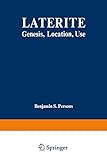Laterite: genesis, location, use [Libro electrónico] / by Benjamin S. Persons
Por: Persons, Benjamin S [autor/a].
Tipo de material: Libro
en línea Series Editor: New York, New York, United States: Plenum Press, c1970Descripción: xiv, 103 páginas : ilustraciones mapa ; 24 centímetros.ISBN: 0306304503; 9781468472172 (Print); 9781468472158 (Online).Tema(s): Laterite | Engineering geologyNota de acceso: Disponible para usuarios de ECOSUR con su clave de acceso Nota de bibliografía: Incluye bibliografía e índice: páginas 99 Número de sistema: 55523Contenidos:Mostrar
Resumen:
Libro
en línea Series Editor: New York, New York, United States: Plenum Press, c1970Descripción: xiv, 103 páginas : ilustraciones mapa ; 24 centímetros.ISBN: 0306304503; 9781468472172 (Print); 9781468472158 (Online).Tema(s): Laterite | Engineering geologyNota de acceso: Disponible para usuarios de ECOSUR con su clave de acceso Nota de bibliografía: Incluye bibliografía e índice: páginas 99 Número de sistema: 55523Contenidos:Mostrar
Resumen:| Tipo de ítem | Biblioteca actual | Colección | Signatura | Estado | Fecha de vencimiento | Código de barras |
|---|---|---|---|---|---|---|
| Libros | Biblioteca Electrónica Recursos en línea (RE) | Acervo General | Recurso digital | ECO400555231813 |
Incluye bibliografía e índice: páginas 99
1. Genesis.. 2. Geology of laterites.. 3. Finding laterites.. 4. Uses of laterite.. 5. Construction techniques.. 6. Maintaining laterite.. Index
Disponible para usuarios de ECOSUR con su clave de acceso
In comparison with engineering, geology is a relatively new domain of know ledge. Man has been building almost from the moment he came down out of the trees or emerged from the caves. All of his structures were founded in or upon rock or soil. Before the end of what we call ancient history, he had learned a great deal about materials, mechanics, and structures. This empirical information had become an organized field of practical knowledge by the time of Leonardo da Vinci. Although both foundations and ma terials of construction were largely earthy, codified knowledge of neither one nor the other existed at that time. During the last two centuries, geology has emerged and has recently begun to take on a more quantitative aspect. A generation ago, it joined hands with civil engineering to create soil mechanics. Engineers began to apply the science of geology to foundations and materials with astoundingly successful results, and geologists began to acquire an understanding of engineering methods, applying what they could to their problems. Geologi cal engineering was born of this union. People of an older time employed stone and brick in construction, although cut brick and sawed stone were used more sparingly because of a scarcity in both suitable raw materials and techniques. They were used in Cambodia, for example. A material able to meet requirements was found nearby, known as itica culla. In India it was called vettu culla, but F. A. eng
Disponible en línea
Disponible en formato PDF
Subscripción a ELSEVIER 26 de diciembre del 2013
